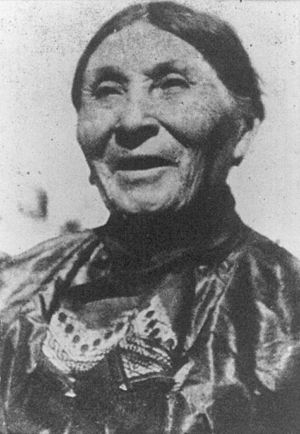Fidelia Fielding facts for kids
Quick facts for kids
Fidelia Hoscott Fielding
|
|
|---|---|
| Dji'ts Bud dnaca ("Flying Bird") | |
 |
|
| Born |
Fidelia Ann Hoscott Smith
September 15, 1827 |
| Died | July 18, 1908 (aged 80) Montville, New London County, Connecticut, U.S.
|
| Resting place | Fort Shantok State Park, Montville, New London County, Connecticut, U.S. |
| Known for | Last speaker of Mohegan-Pequot language |
| Spouse(s) | William H. Fielding (born 1822–died 1889) |
| Parent(s) | Bartholomew Valentine Smith (c. 1811–1843) and Sarah A. Wyyougs (1804–1868) |
| Relatives | Stephanie Fielding |
Fidelia Ann Hoscott Fielding (born Smith; September 15, 1827 – July 18, 1908) was a very important woman. Her Mohegan name was Dji'ts Bud dnaca, which means "Flying Bird." She was the last person known to speak the traditional Mohegan Pequot language fluently.
Fidelia was the daughter of Bartholomew Valentine Smith and Sarah A. Wyyougs. Her grandmother was Martha Shantup Uncas. Fidelia married William H. Fielding, a Mohegan sailor. They lived in a "tribe house," which was a log cabin on the reservation. Fidelia was known for being a strong, independent woman. She knew a lot about her tribe's traditions. She continued to speak the Mohegan language even when she was old.
Contents
Saving the Mohegan Language
Fidelia Fielding strongly believed in using the Mohegan language every day. This was at a time when most Native people in New England were starting to speak mostly English. Her grandmother, Martha Uncas, spoke Mohegan with family members. Other Mohegan people still understood some of the language. But by 1900, very few people spoke it as well as Fidelia and her sister.
Fidelia's Diaries
As an adult, Fidelia kept four diaries. She wrote these diaries in the Mohegan language. These diaries later became very important. They helped experts understand how the Mohegan Pequot language was structured. They also helped with other related Algonquian languages.
Mentoring Gladys Tantaquidgeon
Fidelia was seen as a nanu, which means a respected elder woman. She was a mentor to Gladys Tantaquidgeon. Gladys was another traditional Mohegan woman. She also studied anthropology (the study of human societies and cultures) at the University of Pennsylvania. Gladys worked to preserve Native American cultures. She later founded the Tantaquidgeon Indian Museum with her family.
Frank Speck's Research
Many people believe that a famous anthropologist named Frank G. Speck lived with Fidelia Fielding when he was a child. However, there is no proof of this in Mohegan records or stories. Speck himself said he first met Fidelia around 1900. At that time, he was a student at Columbia University.
Speck was on a camping trip in Connecticut when he met some young Mohegan men. They introduced him to Fidelia. This meeting started a long friendship with the Tantaquidgeon family. Speck interviewed Fidelia and took notes on the Mohegan language. He shared these notes with his professor, John Dyneley Prince. Fidelia eventually let Speck look at her personal diaries. This helped him understand and record the written Mohegan language accurately.
The information Speck gathered from Fidelia led to several important writings. These writings helped share knowledge about the Mohegan language and traditions with more people. After Fidelia's death in 1908, a relative gave her diaries to Frank Speck for safekeeping. These valuable documents are now kept at the Mohegan Archives. They were returned to the Mohegan Tribe on November 4, 2020.
Fidelia's Lasting Impact
Fidelia Fielding passed away on July 18, 1908, in Montville, Connecticut. She is one of only three Native American women to be honored in the Connecticut Women's Hall of Fame. Years later, Gladys Tantaquidgeon, whom Fidelia had trained, was also inducted into the Hall of Fame.
Fidelia was buried at the Ancient Burial Grounds of the Mohegans. This is located at Fort Shantok State Park in Montville, Connecticut. A special memorial marker was placed there to honor her. About 1,000 people attended the ceremony on May 24, 1936.
Honoring Her Legacy
In 1994, Fidelia was honored again. She was inducted into the Connecticut Women's Hall of Fame for her work in Education & Preservation. She is recognized for her huge role in recording and saving the Mohegan language.
During Fidelia's lifetime, many Mohegan parents were afraid to teach their children the language. They worried about being treated unfairly by English speakers. Today, linguists (language experts) from the Mohegan Language Project are working hard. They are using the materials Fidelia and Speck collected. Their goal is to bring the Mohegan-Pequot language back to life for new generations. Stephanie Fielding, a descendant of Fidelia, is part of this important work.

